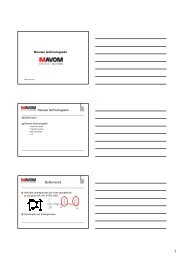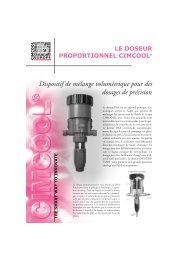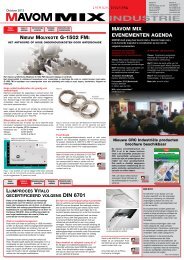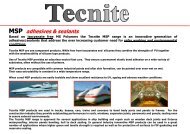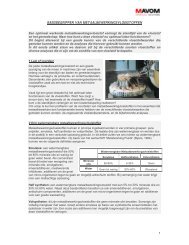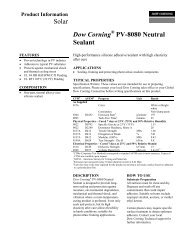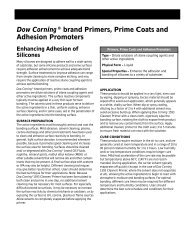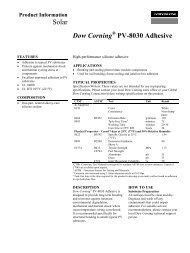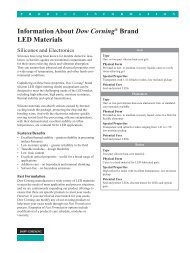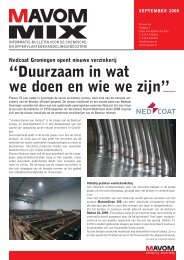DOW CORNING® 200 Fluid Product Information - Mavom
DOW CORNING® 200 Fluid Product Information - Mavom
DOW CORNING® 200 Fluid Product Information - Mavom
You also want an ePaper? Increase the reach of your titles
YUMPU automatically turns print PDFs into web optimized ePapers that Google loves.
<strong>Product</strong> <strong>Information</strong><br />
<strong>DOW</strong> CORNING® <strong>200</strong><br />
<strong>Fluid</strong><br />
FEATURES<br />
• Water-clear silicone fluid available<br />
in viscosities ranging from 0.65 to<br />
60,000 cSt (mm²/s)<br />
• Little change in physical properties<br />
over a wide temperature span - a<br />
relatively flat viscosity-temperature<br />
slope, and serviceability from<br />
40°C up to <strong>200</strong>°C<br />
• Excellent water repellency<br />
• Good dielectic properties over a<br />
wide range of temperatures and<br />
frequencies<br />
• Low surface tension - readily wets<br />
clean surfaces to impart water<br />
repellency and release<br />
characteristics<br />
• Viscosities above 10 mm²/s also<br />
exhibit heat stability, oxidation<br />
resistance, very low vapour<br />
pressures, and high flash point<br />
• Low order of toxicity<br />
• Essentially odourless<br />
• Soluble in a wide range of solvents<br />
• Non-greasy and non-rancidifying<br />
Polydimethylsiloxane<br />
APPLICATIONS<br />
• RELEASE MATERIAL: Used alone or as part of a compounded formula,<br />
<strong>DOW</strong> CORNING <strong>200</strong> <strong>Fluid</strong> provides a non-carbonising mould release for<br />
rubber, plastics, and metal die castings.<br />
• FOAM PREVENTITIVE: Extremely small amounts of the fluid effectively<br />
control foam in many processing operations, especially in non-aqueous<br />
systems.<br />
• MECHANICAL FLUID: Excellent viscosity-temperature characteristics,<br />
thermal and chemical stability, shear-breakdown resistance, compressibility,<br />
and rubber compatibility make <strong>DOW</strong> CORNING <strong>200</strong> <strong>Fluid</strong> outstanding for<br />
mechanical/ hydraulic uses. Typical uses include hydrolic stabilisers, damping<br />
media.<br />
• SURFACE-ACTIVE MATERIAL: Added to vinyl plastisols,<br />
<strong>DOW</strong> CORNING <strong>200</strong> <strong>Fluid</strong> improves the flow characteristics, de-aerates and<br />
lubricates the surface of the completed part.<br />
• LUBRICANT: The fluid provides excellent lubrication for most plastic and<br />
elastomeric surfaces. Lubricity with metals depends upon the combination<br />
involved. Care should be taken to select suitable metals for pumps and other<br />
items with moving parts.<br />
• COSMETICS AND SKIN PREPARATIONS: <strong>DOW</strong> CORNING <strong>200</strong> <strong>Fluid</strong> is<br />
an important ingredient in hand creams, skin protectants, suntan lotions, and<br />
hair grooming aids because it forms a non-greasy, protective film which resists<br />
water and waterborne irritants, yet allows the skin to breathe. Literature is<br />
available that details the use of the fluid in cosmetics.<br />
• POLISHES AND CHEMICAL SPECIALITIES: <strong>DOW</strong> CORNING <strong>200</strong> <strong>Fluid</strong><br />
is used in most automobile and furniture polishes for its ease of application,<br />
high gloss with minimum rubbing, and a durable water-repellant film. It is also<br />
used in many other speciality formulations, including aerosol starches and<br />
fabric conditioners. Additional literature is available.<br />
• ELECTRICAL/ELECTRONIC EQUIPMENT: With excellent dielectric<br />
properties, <strong>DOW</strong> CORNING <strong>200</strong> <strong>Fluid</strong> can be used for both insulating and<br />
damping applications.<br />
• PLASTIC ADDITIVE: Small amounts of <strong>DOW</strong> CORNING <strong>200</strong> <strong>Fluid</strong> can be<br />
compounded into plastic in order to impart surface slip or anti-block and to<br />
improve the processability of the plastic.<br />
HOW TO USE<br />
Since the applications for<br />
<strong>DOW</strong> CORNING <strong>200</strong> <strong>Fluid</strong> are<br />
numerous and varied, application<br />
methods and concentration levels<br />
must be considered on an individual<br />
basis. Contact your local<br />
Dow Corning sales office for specific<br />
information.<br />
Solubility<br />
The solubility of <strong>DOW</strong> CORNING<br />
<strong>200</strong> <strong>Fluid</strong> varies somewhat according<br />
to the viscosity chosen. The low<br />
viscosity grades are more completely
soluble in a given solvent than are the<br />
higher viscosity grades. Since<br />
solubility varies, testing is<br />
recommended before attempting<br />
volume operations. Solubility of the<br />
silicone fluid in a number of<br />
commonly-used solvents is indicated<br />
below. Flammability and toxicity<br />
should also be important<br />
considerations in the choice of a<br />
solvent.<br />
SOLVENTS<br />
Amyl acetate<br />
Benzene<br />
Cyclohexane<br />
Diesel fuel<br />
Ethyl ether<br />
2-Ethyl hexanol<br />
Gasoline<br />
Hexyl ether<br />
Iso-octane<br />
JP-4 jet fuel<br />
Kerosene<br />
Methyl ethyl ketone<br />
Methylene chloride<br />
Methyl ether<br />
Mineral seal oil<br />
Naphtha VM&P<br />
Perchloroethylene<br />
Stoddard solvent<br />
Toluene<br />
Trichloroethylene<br />
Turpentine<br />
Xylene<br />
PARTIAL SOLVENTS**<br />
Acetone<br />
Butanol<br />
Dioxane<br />
Ethanol<br />
Heptadecanol<br />
Isopropanol<br />
NON-SOLVENTS<br />
Cyclohexanol<br />
Dimethylphthalate<br />
Dodecanol<br />
Dowanol* DE<br />
Dowanol* EE<br />
Ethylene glycol<br />
Methanol<br />
Paraffin oil<br />
Propylene glycol<br />
Water<br />
* The Dow Chemical Company.<br />
** Partial Solvents - for lower<br />
viscosity grades.<br />
2<br />
Ref. no. 22-0069N-01<br />
BLENDING<br />
Blending of different viscosity grades<br />
of <strong>DOW</strong> CORNING <strong>200</strong> <strong>Fluid</strong><br />
permits any desired viscosity.<br />
Although the fluid is available in a<br />
number of standard viscosity grades,<br />
occasionally an application will call<br />
for a fluid of a viscosity between the<br />
standard grades.<br />
To use the blending chart (Figure 3):<br />
1. Draw a line between two points -<br />
one on the lefthand scale representing<br />
the higher viscosity fluid available;<br />
and one on the right, the lower<br />
viscosity fluid.<br />
2. Draw another line across the chart<br />
at the desired viscosity rating.<br />
3. Draw a third line, vertically<br />
through the intersection of the first<br />
two lines.<br />
4. Read off the top and bottom scales<br />
the proportions of the available fluids<br />
to blend to obtain the desired<br />
viscosity.<br />
Accuracy will be increased by<br />
blending the two fluids which<br />
immediately bracket the desired<br />
viscosity. If a very accurate blend is<br />
required, it may be necessary to adjust<br />
the viscosity of the mixture by a<br />
second blending.<br />
HANDLING PRECAUTIONS<br />
Tests have established that<br />
<strong>DOW</strong> CORNING <strong>200</strong> <strong>Fluid</strong> is<br />
essentially non-toxic and nonirritating<br />
(although temporary<br />
discomfort may result if rubbed into<br />
the eye).<br />
PRODUCT SAFETY<br />
INFORMATION REQUIRED FOR<br />
SAFE USE IS NOT INCLUDED.<br />
BEFORE HANDLING, READ<br />
PRODUCT AND SAFETY DATA<br />
SHEETS AND CONTAINER<br />
LABELS FOR SAFE USE,<br />
PHYSICAL AND HEALTH<br />
HAZARD INFORMATION. THE<br />
SAFETY DATA SHEET IS<br />
AVAILABLE FROM YOUR LOCAL<br />
<strong>DOW</strong> CORNING SALES<br />
REPRESENTATIVE.<br />
USABLE LIFE AND<br />
STORAGE<br />
When stored at or below 60°C in the<br />
original unopened containers<br />
<strong>DOW</strong> CORNING <strong>200</strong> <strong>Fluid</strong> has a<br />
variable usable life, ranging from 30<br />
to 60 months from the date of<br />
production, depending on the<br />
viscosity grade (mm²/s) selected.<br />
<strong>DOW</strong> CORNING <strong>200</strong> <strong>Fluid</strong> has a<br />
viscosity lower than 5mm²/s are<br />
flammable. Keep away from heat and<br />
open flames.<br />
RECYCLING AND<br />
DISPOSAL OPTIONS<br />
Recycling options include re-use of<br />
the material in the same application<br />
with or without reprocessing.<br />
Reprocessing methods include<br />
filtration, absorption and/or<br />
distillation depending on the type of<br />
contamination. Fuel blending is<br />
another form of recycling where the<br />
"spent" fluid is mixed with<br />
compatible organic solvents or other<br />
fuels and used as a substitute<br />
feedstock in an industrial furnace such<br />
as cement kiln. The silicone fluid will<br />
be thermally converted to energy and<br />
to a silica residue which may be<br />
incorporated into the end product.<br />
Incineration is a viable alternative for<br />
direct disposal. Landfilling liquids or<br />
fluids is not recommended, however<br />
absorbents or other solid materials<br />
contaminated with silicone fluid can<br />
be buried as solid waste.<br />
LIMITATIONS<br />
This product is neither tested nor<br />
represented as suitable for medical or<br />
pharmaceutical uses.<br />
HEALTH AND<br />
ENVIRONMENTAL<br />
INFORMATION<br />
To support customers in their product<br />
safety needs, Dow Corning has an<br />
extensive <strong>Product</strong> Stewardship<br />
organization and a team of Health,<br />
Environment and Regulatory Affairs<br />
specialists available in each area.<br />
For further information, please<br />
consult your local Dow Corning<br />
representative.
WARRANTY<br />
INFORMATION - PLEASE<br />
READ CAREFULLY<br />
The information contained herein is<br />
offered in good faith and is believed<br />
to be accurate. However, because<br />
conditions and methods of use of our<br />
products are beyond our control, this<br />
information should not be used in<br />
substitution for customer's tests to<br />
ensure that Dow Corning's products<br />
are safe, effective, and fully<br />
satisfactory for the intended end use.<br />
Dow Corning's sole warranty is that<br />
the product will meet the<br />
Dow Corning sales specifications in<br />
effect at the time of shipment. Your<br />
exclusive remedy for breach of such<br />
warranty is limited to refund of<br />
purchase price or replacement of any<br />
product shown to be other than as<br />
warranted. Dow Corning specifically<br />
disclaims any other express or implied<br />
warranty of fitness for a particular<br />
purpose or merchantability. Unless<br />
Dow Corning provides you with a<br />
specific, duly signed endorsement of<br />
fitness for use, Dow Corning<br />
disclaims liability for any incidental<br />
or consequential damages.<br />
Suggestions of use shall not be taken<br />
as inducements to infringe any patent.<br />
3<br />
Ref. no. 22-0069N-01
Table 1: Typical properties of viscosity grades.<br />
These values are not intended for use in preparing specifications.<br />
Viscosity<br />
at 25°C¹<br />
mm²/s<br />
(cSt)<br />
Flash<br />
Point,<br />
closed<br />
cup²<br />
Flash<br />
Point,<br />
open cup 3<br />
Pour<br />
Point 4<br />
Specific<br />
Gravity<br />
at 25°/<br />
15.6°C ¥<br />
Viscosity<br />
Temperature<br />
Coefficient 6<br />
Coefficient of<br />
Volume<br />
Expansion, 7<br />
I/K<br />
Refractive<br />
Index 8 at<br />
25°C<br />
Surface<br />
Tension 9 at<br />
25°CmN/m<br />
Thermal<br />
Conductivity 10 at<br />
50°C<br />
Boiling Point<br />
0.65 -3.3°C -68°C 0.761 0.31 0.00134 1.375 15.9 0.100 100°C at 760mm<br />
(10.1 kPa)<br />
1.0 34.4°C -100°C 0.818 0.41 0.00134 1.382 17.4 - 152°C at 760 mm<br />
5.0 >100°C 135°C -100°C 0.920 0.55 0.00105 1.397 19.7 - 120-160°C at 0.5mm<br />
VOLATILITY 11<br />
% max weight loss<br />
after 24 hrs at 150°C<br />
10 >100°C >163°C -100°C 0.934 0.56 0.00108 1.399 20.1 0.134 10<br />
20 >100°C >204°C -84°C 0.949 0.59 0.00107 1.400 20.6 0.142 10<br />
50 >100°C >285°C -70°C 0.960 0.59 0.00104 1.401 20.8 - 2.0<br />
100 >100°C >315°C -65°C 0.960 0.60 0.00096 1.402 20.9 0.155 0.5<br />
<strong>200</strong> >100°C >315°C -65°C 0.970 0.60 0.00096 1.403 21.0 - 0.5<br />
300 >100°C >315°C -65°C 0.970 0.60 0.00096 1.403 21.0 0.155 0.5<br />
350 >100°C >315°C -65°C 0.970 0.60 0.00096 1.403 21.1 0.159 0.5<br />
500 >100°C >315°C -50°C 0.971 0.60 0.00096 1.403 21.1 - 0.5<br />
1000 >100°C >321°C -50°C 0.971 0.61 0.00096 1.403 21.2 0.159 0.5<br />
5000 >100°C >321°C -50°C 0.975 0.61 0.00096 1.403 21.4 0.159 2.0<br />
10000 >100°C >321°C -50°C 0.975 0.61 0.00096 1.403 21.5 0.159 2.0<br />
12500 >100°C >321°C -46°C 0.975 0.61 0.00096 1.403 21.5 0.155 2.0<br />
30000 >100°C >321°C -43°C 0.975 0.61 0.00096 1.403 21.5 - 2.0<br />
60000 >100°C >321°C -41°C 0.976 0.61 0.00096 1.403 21.5 - 2.0<br />
1. CTM 0004<br />
2. CTM 0021<br />
3. CTM 0006<br />
4. CTM 0133. Due to the effects of supercooling, this test method<br />
yields pour points lower than the temperatures at which these<br />
silicone fluids solidify when held at such temperatures for a<br />
longer period.<br />
5. CTM 0001A<br />
6. CTM 0747 (1 - (Viscosity at 99°C / Viscosity at 38°C))<br />
7. CTM 0420<br />
8. CTM 0002<br />
9. CTM 0461<br />
10. CTM 0773 O.K. Bates, “Thermal Conductivity of Liquid<br />
Silicones”, Industrial and Engineering Chemistry, Vol. 41,<br />
page 1966, September 1949, units were W/(m.K).<br />
11. CTM 208. Determined by heating a 2 gram sample in a 50<br />
millilitre beaker for 24 hours at 150°C. The heating is carried out<br />
in an air circulating oven.<br />
Figure 1: Viscosity temperature slopes for <strong>DOW</strong> CORNING <strong>200</strong> <strong>Fluid</strong>s and some petroleum oils.<br />
4<br />
Ref. no. 22-0069N-01
Figure 2: Compressibility of <strong>DOW</strong> CORNING <strong>200</strong> <strong>Fluid</strong>.<br />
Figure 3: Blending Chart.<br />
5<br />
Ref. no. 22-0069N-01
6 05/01/1998<br />
® <strong>DOW</strong> CORNING is a registered trademark of Dow Corning Corporation.<br />
Ref. no. 22-0069N-01<br />
DC 2870<br />
©1997-<strong>200</strong>0 Dow Corning Corporation. All rights reserved.



